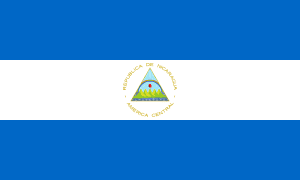
| Colors | HEX Code | RGB | CMYK |
|---|---|---|---|
| Blue | #0067C6 | 0, 103, 198 | 100, 48, 0, 22 |
| White | #FFFFFF | 255, 255, 255 | 0, 0, 0, 0 |
| Yellow | #CCAB14 | 204, 171, 20 | 0, 16, 90, 20 |
| Sky Blue | #75DAF3 | 117, 218, 243 | 52, 10, 0, 5 |
| Green | #94BF2D | 148, 191, 45 | 23, 0, 76, 25 |
The flag of Nicaragua is a bicolor with three equal horizontal stripes. The upper and lower stripes are blue, while the middle stripe is white. In the center of the flag, there is a coat of arms that features a triangle representing equality with five volcanoes, representing the five original Central American countries (including Nicaragua), a rising sun symbolizing the new nation, a Cap of Liberty representing freedom, and a rainbow symbolizing peace. The name of the country, “República de Nicaragua,” is inscribed in Spanish around the outer circle of the coat of arms.
Meaning of the flag of Nicaragua
The blue and white colors were adopted from the five Central American States common flag that was hoisted upon gaining independence from Spain. The blue represents the Pacific Ocean and the Caribbean Sea, while white symbolizes purity and virtue. The coat of arms on the flag features a triangle that represents equality. The liberty cap signifies freedom. The five volcanoes between two oceans stand for the five original Central American countries that are located between the Atlantic and Pacific Oceans. The coat of arms also represents Nicaragua’s natural beauty, freedom, and independence.
History of the Flag of Nicaragua
The five countries of Central America Costa Rica, El Salvador, Guatemala, Honduras, and Nicaragua were ruled by Spain. In 1821, the 5 countries proclaimed their independence from Spain, and the United Provinces of Central America adopted a new flag that had three horizontal blue-white-blue stripes with a coat of arms in the center. When the federation collapsed, Nicaragua kept the same flag as the United Provinces. Although the stripes were not changed, the coat of arms was modified twice, in 1908 and 1971.